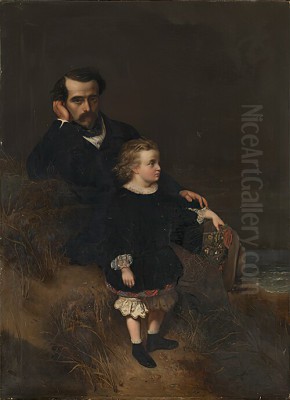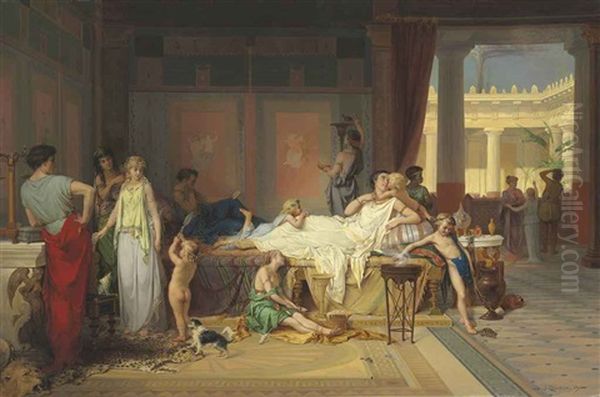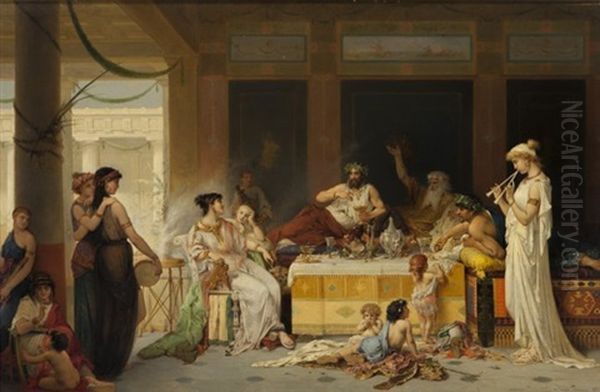
Pierre Olivier Joseph Coomans stands as a significant figure in 19th-century Belgian art. Born in Brussels on June 28, 1816, and passing away in Boulogne-sur-Seine, France, on December 31, 1889, Coomans carved a niche for himself as a distinguished painter of historical subjects, evocative genre scenes, and captivating landscapes. His artistic journey reflects the confluence of rigorous academic training, the emotional depth of Romanticism, and a fascination with the distant past, particularly the classical world and the allure of the Orient.
Coomans's life and work were characterized by a blend of meticulous craftsmanship and a penchant for narrative richness. He navigated the evolving artistic landscape of his time, achieving considerable success not only in his native Belgium but also internationally, particularly finding favour with American collectors. His legacy is one of technical proficiency combined with an ability to transport viewers to different eras and cultures, rendered with sensitivity and aesthetic appeal.
Early Life and Artistic Formation
Born into an educated family in Brussels, Pierre Olivier Joseph Coomans was the son of Joseph Coomans, an inspector of registration and estates, and Cécile Sleperet, who was herself a novelist and poet. This environment likely fostered an appreciation for culture and narrative from a young age. His innate talent for drawing and painting became evident early on, leading him to pursue formal artistic training.
At the age of sixteen, Coomans began his studies, initially learning under Pieter van Hanselaere in Ghent. He later continued his education at the prestigious Royal Academy of Fine Arts in Antwerp. There, he benefited from the tutelage of prominent figures in the Belgian art establishment, including Nicaise de Keyser and Baron Gustave Wappers. These instructors were key proponents of the Belgian Romantic-historical school, instilling in Coomans a strong foundation in academic principles – emphasizing structured composition, technical precision, and the importance of historical or mythological subject matter. His early work, such as Young Greek Shepherd, already showcased his burgeoning skills and thematic interests.
Travels and the Influence of the Orient

Coomans's artistic perspective was significantly broadened by his travels. A pivotal experience was his time spent in North Africa, specifically Algeria, between 1843 and 1845. He accompanied the French army, an opportunity that exposed him directly to the landscapes, cultures, and peoples of the region. This period proved immensely fruitful for his art, immersing him in the aesthetics of Orientalism, a popular theme in 19th-century European art.
During his time in Africa, Coomans diligently sketched and painted, capturing the unique light, vibrant colours, and distinct atmosphere of the Maghreb. His works from this period include detailed North African landscapes, compelling portraits of Arab figures, and dynamic battle scenes. Paintings like Landscape in the Province of Constantine and Emigration of Arab Tribes emerged from these experiences, showcasing his ability to render exotic locales and dramatic human activity. These travels infused his work with fresh subject matter and a richer palette, distinguishing him within the Belgian art scene.
Beyond North Africa, Coomans continued to travel, seeking inspiration in other historically rich regions. He journeyed through Italy, Turkey, Greece, and even Crimea. Each location offered new visual stimuli and historical layers that would subtly inform his later work. However, it was his experiences in Italy that would prove most transformative for the direction of his art.
The Revelation of Pompeii
A turning point in Coomans's artistic career occurred during his travels in Italy, particularly his visit to the archaeological sites of Pompeii and Herculaneum around 1857. The unearthing of these ancient Roman cities, preserved under volcanic ash since the eruption of Mount Vesuvius in 79 AD, captivated the European imagination. For Coomans, the direct encounter with the art, architecture, and everyday objects of Roman life was a profound revelation.
He became deeply engrossed in studying the frescoes, mosaics, and artifacts discovered at Pompeii. The intimate glimpses into the daily lives of the ancient Romans – their homes, their leisure activities, their aesthetics – resonated strongly with him. This experience steered his artistic focus decisively towards classical antiquity. From this point forward, Coomans dedicated a significant portion of his output to depicting scenes inspired by ancient Rome and Greece, often specifically set within Pompeian contexts.

His approach was not merely archaeological reconstruction but aimed to capture the spirit and atmosphere of classical life. He populated his canvases with figures drawn from Roman society – elegant women, poets, musicians, flower sellers, children at play – often placing them in meticulously rendered domestic interiors or garden settings based on Pompeian villas. This thematic shift defined the mature phase of his career and became the style for which he was most widely recognized.
Artistic Style: Academicism Meets Romanticism
Coomans's art is best understood as a sophisticated blend of Academicism and Romanticism. From his training at the Antwerp Academy under figures like De Keyser and Wappers, he inherited a strong respect for academic principles: clarity of drawing, balanced composition, smooth finish, and adherence to established artistic conventions. His works demonstrate meticulous attention to detail, particularly in rendering textures, fabrics, and architectural elements.
However, Coomans infused this academic structure with a Romantic sensibility. His paintings often possess a poetic, sometimes sentimental, quality. He excelled at capturing subtle emotional nuances in his figures, particularly in his depictions of women and children. There is a prevailing sense of grace, elegance, and often a gentle melancholy or quiet contemplation in his genre scenes. His use of light and colour, while controlled, contributes to the overall mood, often creating soft, harmonious effects.
His Pompeian scenes, while grounded in archaeological study, are ultimately romanticized visions of antiquity. He focused on the idyllic, domestic, and personal aspects of Roman life rather than grand historical events. This focus on intimate moments, combined with his refined technique and appealing subject matter, resonated strongly with the tastes of the bourgeois collectors of his time. He masterfully balanced historical accuracy with aesthetic charm.
Representative Works
Throughout his prolific career, Pierre Olivier Joseph Coomans created numerous paintings that captured the public's imagination. Several works stand out as particularly representative of his style and thematic concerns:
The Last Hour of Pompeii and The House of the Poet, Pompeii: These titles, sometimes used interchangeably or referring to related works, exemplify his fascination with the ancient city. They likely depict poignant scenes set within Pompeian villas just before or during the catastrophic eruption, blending historical drama with intimate domestic settings. These works showcase his ability to reconstruct ancient interiors and imbue them with human emotion.
The Pompeian Flower Girl: This is one of Coomans's iconic images, portraying a young woman in classical attire, perhaps selling or arranging flowers. It embodies his idealized vision of Roman daily life, emphasizing beauty, youth, and simple pleasures within an antique setting. The careful rendering of fabrics, flowers, and architectural details is typical of his style.
Secret Love: This painting highlights Coomans's skill in conveying subtle emotions and narrative suggestions. Likely featuring a female figure in a moment of private reflection or clandestine communication, it speaks to the Romantic interest in inner feelings and hidden stories. The work would showcase his sensitive handling of the human form and expressive potential.
Vestalis (The Vestal Virgin): Depicting a priestess of Vesta, the Roman goddess of hearth and home, this work taps into classical mythology and religious practice. It allowed Coomans to explore themes of purity, duty, and the sacred within an ancient Roman context, often rendered with his characteristic elegance and attention to classical attire and setting.
Roman Banquet: This subject provided an opportunity for Coomans to depict a more elaborate social scene from antiquity. Such works would demonstrate his ability to handle multi-figure compositions, showcasing Roman customs, costumes, and decorative arts, while still maintaining a sense of refined atmosphere rather than excessive decadence.
Other notable works reflecting his diverse interests include The Deluge, demonstrating his handling of dramatic historical or biblical themes, and paintings derived from his North African travels like Landscape in the Province of Constantine and Emigration of Arab Tribes.
Coomans in the Context of 19th-Century Art
Pierre Olivier Joseph Coomans operated within a vibrant and complex European art world. In Belgium, he was part of a generation deeply influenced by the establishment of the nation in 1830 and a subsequent desire to forge a distinct national artistic identity, often through historical painting. His teachers, Nicaise de Keyser (1813-1887) and Gustave Wappers (1803-1874), were central figures in this movement, promoting a Romantic-historical style that combined dramatic flair with nationalistic themes. Pieter van Hanselaere (1786-1862) represented an earlier, more Neoclassical influence.
Other prominent Belgian contemporaries included Antoine Wiertz (1806-1865), known for his often grandiose and eccentric historical and mythological paintings, and Louis Gallait (1810-1887), another leading historical painter celebrated for works like The Abdication of Charles V. Hendrik Leys (1815-1869), a fellow Antwerp artist, initially worked in a Romantic style similar to Wappers but later developed a more archaicizing manner influenced by 16th-century German and Flemish masters. Alfred Stevens (1823-1906), though Belgian, achieved fame in Paris for his elegant depictions of fashionable modern women, representing a different direction from Coomans's historical focus.
Internationally, Coomans's work, particularly his Pompeian scenes and Orientalist pieces, aligns him with broader European trends. His interest in classical antiquity, filtered through a romantic and anecdotal lens, bears comparison to the work of the highly successful Dutch-born British painter Lawrence Alma-Tadema (1836-1912), who became renowned for his meticulously researched and polished scenes of Roman and Egyptian life. Similarly, the French painter Jean-Léon Gérôme (1824-1904) excelled in both Orientalist subjects and historical reconstructions, including scenes from antiquity, often with a strong emphasis on ethnographic or archaeological detail.
While Coomans maintained an academic finish, his work differs from the stricter Neoclassicism of earlier figures like Jean-Auguste-Dominique Ingres (1780-1867). His embrace of emotion and exoticism connects him more broadly to the Romantic movement, which included giants like Eugène Delacroix (1798-1863), a master of Orientalist themes and dramatic historical narratives, and Théodore Géricault (1791-1824), whose work emphasized dynamism and emotional intensity. Coomans carved his own path by blending these influences into a highly popular and accessible style.
International Recognition and Artistic Legacy
Pierre Olivier Joseph Coomans achieved significant recognition during his lifetime, extending far beyond the borders of Belgium. His paintings, particularly the charming and accessible Pompeian genre scenes, proved immensely popular with collectors, especially in the burgeoning art market of the United States. His works were exhibited internationally, including in America, contributing to his reputation as a commercially successful European artist. The mention of his work appearing in collections like that of Garret and Jennie Hobart underscores this transatlantic appeal.
The popularity of his paintings was further amplified by the widespread circulation of reproductions. Through engravings and photographic prints, images of Coomans's work reached a broad audience, making his idealized visions of antiquity familiar features in many middle-class homes in Europe and America. This dissemination cemented his fame and contributed to the prevailing taste for historical and classical subjects in the latter half of the 19th century.
Coomans's artistic legacy was also carried on by his family. He married twice, first to Zoé van Male de Brachene (who died in 1848) and later to Adélaïde Zoé de Rongé (1817-1884). From his second marriage, he had two daughters, Heva Coomans (1860-1939) and Diana Coomans (1861-1952). Both daughters became painters in their own right, working in a style closely resembling their father's, often depicting similar classical genre scenes. They moved to Paris and exhibited their works, further perpetuating the Coomans name and artistic style into the early 20th century.
Later Life and Enduring Appeal
In his later years, Coomans continued to paint, primarily focusing on the classical themes that had brought him such success. He spent considerable time in Paris, a major center of the art world, although he maintained connections to Belgium. His dedication to his chosen subjects remained steadfast, even as newer artistic movements like Impressionism began to challenge the dominance of academic and historical painting.
Pierre Olivier Joseph Coomans passed away on December 31, 1889, in Boulogne-sur-Seine, a commune near Paris. He left behind a substantial body of work characterized by technical skill, romantic charm, and a deep engagement with history, particularly the allure of ancient Rome.
Today, Coomans's paintings are appreciated for their aesthetic qualities and as reflections of 19th-century tastes and interests. While perhaps overshadowed by more revolutionary figures of his era, his work holds a distinct place in the history of Belgian art and the broader phenomenon of historical genre painting. His ability to create accessible, beautifully rendered visions of the past continues to attract viewers and collectors.
Collections and Market Presence
Works by Pierre Olivier Joseph Coomans can be found in various public and private collections, although specific institutional holdings are not always widely documented. His connection to Belgian art centers like Ghent and Antwerp suggests his work was exhibited and likely collected there during his lifetime. His presence in American collections, such as the historical Garret and Jennie Hobart Collection, confirms his international reach.
Coomans's paintings continue to appear on the art market, demonstrating sustained interest among collectors. Auction records provide insight into the value attributed to his work. For instance, his painting Spielende Kinder im antiken Interieur (Children Playing in an Antique Interior), dated 1880, was sold at VAN HAM Fine Art Auctions in May 2020 for a price within the estimate of €5,000-€6,000. Another work, Junges Mädchen mit Vögeln - Vögel im Käfig (Young Girl with Birds - Birds in Cage), fetched a price between €1,600 and €2,000 at Kunstauktion Hannover in 2020. These sales indicate a consistent, if not top-tier, market for his charming and well-executed paintings. His legacy endures through these works that continue to circulate and find appreciation for their historical context and artistic merit.